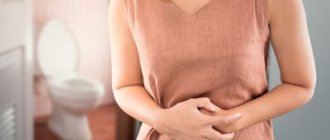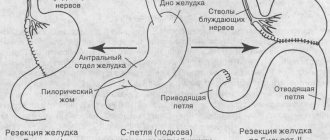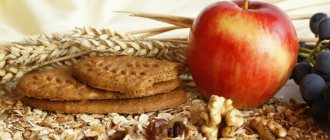What is constipation?
According to modern concepts, the diagnosis of constipation is established when a patient has two or more of the following symptoms: stool less than 3 times a week, hard or fragmented stool (even if it is daily), a feeling of incomplete bowel movement, a sensation of obstruction in the rectal area, the need to strain during bowel movements, to help yourself with your hands.
The so-called Bristol stool shape scale allows you to visually imagine the consistency of stool, characteristic of constipation. Constipation is characterized by the first and second types of stool on this scale.
Causes of dry, dark-colored stool
When hard, dark-colored stool appears, it is worth remembering what the person ate the day before, what medications he took.
When hard, dark-colored stool appears, it is worth remembering what the person ate the day before, what medications he took. Prunes, black currants, beets, blueberries and other products can give a dark color. The color of the excrement often lasts for several days.
Stools may become black or dark brown due to medications. For example, iron supplements or activated carbon.
But the most dangerous cause of black stool is internal bleeding. During its passage through the intestines, the blood coagulates and darkens, coloring the food bolus accordingly.
Causes of constipation in adults
Short-term episodes of constipation may be associated with changes in everyday life, diet, and lack of comfortable conditions for visiting the toilet (for example, a trip to another city or country). The cause may also be stress, pregnancy, decreased physical activity, incl. forced bed rest. Such constipation is called temporary, and stools usually return to normal after returning to your normal lifestyle. In these cases, constipation has an explanation and most often does not require seeing a doctor.
At the same time, there is also chronic constipation, in which symptoms last for several months or more; it can be primary (or functional) and secondary. What is their difference?
With functional constipation, the cause of stool retention is a violation of intestinal motility (peristalsis). In this case, quite often there is a decrease in the motor activity of the intestine, less often - increased, but uncoordinated peristalsis. All this leads to a slow passage of feces through the intestinal tube, i.e. to the development of constipation. This problem very often arises due to poor nutrition (lack of dietary fiber and fluid in the diet, eating 1-2 times a day), insufficient physical activity (the so-called “sedentary lifestyle”).
In a number of patients with functional constipation, the movement of feces through the intestines is normal, but there is a problem with the act of defecation (i.e., bowel movement) due to uncoordinated work of the pelvic floor muscles.
The group of people with functional constipation can also include patients with the so-called irritable bowel syndrome. But in addition to constipation, they also experience abdominal pain.
As for secondary constipation, their cause may be a mechanical obstruction to the passage of feces (intestinal tumors, abdominal adhesions), the presence of inflammation in the intestines, anatomical features (long intestine) and a number of other diseases, and not necessarily intestinal diseases. Diabetes mellitus, deficiency of thyroid hormones, depression, multiple sclerosis are just some of the diseases that lead to constipation. These individuals may experience so-called anxiety symptoms (blood in the stool, unmotivated weight loss, causeless increase in body temperature), which requires consulting a doctor.
In case of chronic constipation, whether it is functional or a symptom of another disease, it is necessary to consult a gastroenterologist and undergo an examination. Modern diagnostic methods - colonoscopy, blood and stool tests - in most cases make it possible to clarify the cause of constipation.
Diagnostics
A gastroenterologist examines patients with mushy stools. First, the doctor takes a medical history, performs a physical examination, and checks for symptoms of peritoneal irritation to rule out an “acute abdomen.” Then a set of instrumental and laboratory studies of the digestive tract is prescribed to clarify the cause of dyspeptic disorders. The most informative diagnostic methods:
- Sonography
. During an ultrasound of the intestine, the general anatomical features of the intestine are studied, dilated loops or thickening of the intestinal wall are identified, which serves as a sign of specific inflammatory changes. Targeted ultrasound of the liver helps to identify structural heterogeneity, neoplasms or abscesses. - Endoscopy
. A colonoscopy with examination of the entire colon is informative, which allows you to identify common causes of pasty bowel movements in older people - Crohn's disease, diverticulosis, neoplasms. If gastritis or duodenitis is suspected, an endoscopy with a biopsy is performed, a test for cell metaplasia by staining with methylene blue. - Radiography
. Irrigoscopy with double contrast effectively detects ulcerative-destructive disorders, intestinal abnormalities or tumor formations. During the X-ray examination of the passage of barium through the intestines, peristalsis is checked, motor dyskinesias are excluded, and inflammatory processes in the upper gastrointestinal tract are diagnosed. - Coprogram
. Pasty stool in an adult is visually assessed using the Bristol scale. Microscopic analysis is intended to determine signs of malabsorption and inflammation. Be sure to do an analysis for intestinal dysbiosis and culture of stool on nutrient media to confirm the infectious cause of defecation disorders. - Blood tests
. Liver tests and measurement of the concentration of bilirubin fractions are carried out to exclude concomitant damage to the biliary tract. With liver disease, the protein content in the blood is reduced. An immunological blood test is necessary to identify antibodies to intestinal pathogens. The hormonal profile must be examined. - Additional methods
. To confirm helicobacteriosis, they look for fecal antigen or perform a rapid urease test. In case of doubtful liver tests, duodenal intubation with bacterial culture of the obtained bile and RCP are performed. To exclude abdominal ischemia syndrome, Doppler ultrasound of the abdominal vessels is recommended.
What to do if you are constipated
If you have functional constipation, the following recommendations can help you achieve normal bowel movements:
1) Lifestyle correction.
- There should be no morning rush; you need to set aside enough time to go to the toilet before school or work.
- Sometimes a hearty breakfast is a kind of stimulus for the appearance of stool. The generally accepted ideal time to go to the toilet is 15-30 minutes after breakfast.
- It is very important that you go to the toilet at the same time and regularly, this way we accustom the intestines to normal stool.
- Try to create conditions for a comfortable stay in the toilet, ask your relatives not to disturb you for a certain time, not to rush you.
- If the urge to defecate occurs during the day, do your best to go to the toilet.
2) Exercises to activate intestinal motility.
- Self-massage the abdomen with a circular motion of the palm in a clockwise direction before and during visiting the toilet.
- Before going to the toilet: imitate cycling, exercise the abdominal muscles (for example, inhale air, drawing in the stomach, and then “throw” the stomach forward as you exhale).
3) Nutrition correction. Eating regularly 3-4 times a day, consuming enough liquid (1.5-2 liters of drinks and liquid meals per day in the absence of contraindications), consuming enough fiber are important steps to normalize stool. It is known that residents of our country eat on average 16-18 g of fiber per day with a norm of up to 30-35 g, while in order to maintain this norm, you need to consume at least 400 g of fruits and vegetables per day.
In the absence of contraindications, it is preferable to consume vegetables and fruits raw, while in case of increased intestinal motility, heat treatment of vegetables (cooking, stewing) is mandatory.
Stimulation of stool can be facilitated by the consumption of fermented milk products, dried fruits, vegetable oil, honey (in the absence of contraindications), and the addition of coffee to the diet. By the way, drinking a glass of cool drink (water or juice) in the morning on an empty stomach often has a laxative effect. You can also use some mineral waters as recommended by your doctor. Since easily digestible carbohydrates slow down bowel movements, patients with constipation should limit white cereals (such as rice, semolina) and pasta.
In the modern world, where the Western type of diet predominates, with a large amount of refined foods and easily digestible carbohydrates, it is sometimes very difficult to maintain such a varied diet, so the high prevalence of constipation is not surprising. It is not for nothing that it is considered a disease of civilization. And by the way, another possible cause of constipation associated with modern civilization is the widespread use of toilets.
How are these related, you ask? Look: when sitting on the toilet, the pelvic muscles squeeze the rectum, making it difficult to empty. The most physiological way is to defecate while squatting (as people did at all times before), otherwise it is called the “eagle pose.” In this case, our hips and pelvis create an angle of approximately 35 degrees, there is no pressure on the rectum. However, we are people accustomed to convenience, and, of course, we will not refuse toilets. Therefore, you can use an alternative technique to create the desired body position - using a low footrest next to the toilet. This will automatically lift your legs and create the desired angle.
Treatment
Treatment of diarrhea in a child should be carried out by a specialized specialist - a pediatrician or pediatric gastroenterologist. Only a doctor can adequately assess the severity of the patient’s condition and prescribe rational therapy.
If the disease is mild, the child is given more fluids to drink to quickly make up for the deficiency. If severe dehydration develops, hospitalization and intravenous saline solutions will be required3,7.
Diet therapy
In order for intestinal function to recover faster, it is important to monitor the child’s nutrition. If the diarrhea is mild and there are no signs of intoxication, in older children the amount of food should be reduced by 15-20%. The food must be well prepared; it is better to serve the dish pureed or mashed. From 3-5 days you can return to your previous diet. With moderate diarrhea, in the first days the amount of food is reduced by 20-30%, and over the course of 4-6 days they gradually return to the usual menu14.
It is advisable not to consume foods that increase diarrhea. Food containing soft fiber should be added to the menu14.
Diet for diarrhea with mucus in a child14
| Products to exclude | Recommended Products |
|
|
Up to contents
Consequences of constipation
Constipation is always a symptom of disorders in the body, so diagnosis and treatment are necessary. Dangers of regular constipation:
- development of an imbalance of intestinal microflora (dysbacteriosis), which provokes a decrease in local and general immunity, disrupts digestion processes, and causes deficiencies of vitamins, microelements, and nutrients;
- dysfunctions and diseases of the gastrointestinal tract (diverticulosis, hemorrhoids, inflammatory processes, etc.);
- intoxication of the body due to prolonged presence of feces in the intestinal cavity;
- formation of polyps, intestinal tumors;
- intestinal obstruction.
The only correct solution for constipation is to contact a gastroenterologist to exclude serious diseases, examination and correction of the condition.
White dry stool
Small dense grains of yellowish or white color may appear in infants fed breast milk. This is the norm and does not require treatment.
In adults, dry white feces can occur due to dietary habits. Dairy products and plant foods give stool a light color. If you consume little fiber when you are addicted to such foods, the stool becomes white and dry. To cope with the problem, it is enough to reconsider your diet and diet.
Pathological causes are the formation of light gray feces. Such bowel movements indicate blockage of the gallbladder ducts, inflammatory diseases of the liver or pancreas, viral infections, and dysbacteriosis.
Diagnosis and treatment of constipation at the EXPERT Clinic
What and how can we help you?
- Consult with a competent specialist - our gastroenterologist will examine you in detail, if necessary, prescribe additional consultations with related specialists and monitor the treatment process, from the first visit to the result.
- To identify the cause of constipation - we have all the necessary expert-class equipment and highly qualified diagnostic specialists to conduct a detailed examination - tests, ultrasound, endoscopic examinations.
- Save you time and money - to find out why your intestines are refusing to work regularly, we have created a free conversation with a gastroenterologist to schedule an examination. If you are concerned about your symptoms, but you don’t know where to start, during the conversation you will be prescribed the necessary range of tests.
How is the child examined?
In most cases, diarrhea with mucus does not require any specific examination7. The doctor assesses the child’s condition, examines him and, based on this, makes recommendations for treatment. To distinguish infectious causes of mucous diarrhea from non-infectious ones, the pediatrician prescribes laboratory tests and instrumental research methods4,7.
For a correct diagnosis, you should inform the doctor about the child’s eating habits, recently taken medications, and a tendency to allergies2.
Up to contents
Dry feces: what to do and how to soften it
The following will help make your stool regular and softer:
- Laxatives - softening of stool will occur quickly and the body can easily cleanse itself of accumulated feces, the main thing is to choose the right medicine.
- An enema is a very good way to liquefy stool, but this method is not allowed for everyone, and it has a bad effect on the intestines. Therefore, they soften feces in this way only as a last resort and only if there are no contraindications.
- Softening folk remedies have proven themselves to be effective since ancient times. Such substances do not act immediately, but the small and large intestines do not suffer from their intake. A large selection of laxative food allows you to choose not only healthy, but also tasty food.
It is quite easy to purchase a laxative that softens stool at a pharmacy, but choosing the right one is sometimes difficult. Laxatives are selected depending on the cause of constipation.
If constipation is caused by stress or moving, then you can choose fast-acting drugs based on senna or buckthorn, or castor oil. Such drugs should not be used frequently, as they can cause intestinal atony. But they work very well.
You can also take various oils to help liquefy stool and stimulate bowel movements. Flaxseed, mineral and petroleum jelly oils will cope with this task perfectly, but you should also not be overzealous with these drugs. If constipation is chronic and the stool is constantly hard, then osmotic substances can soften it. They work in the intestines themselves, leading to an influx of water rather than an outflow, resulting in softer stool.
Liquefied stool passes through the intestines more easily and is more susceptible to peristalsis. Also, for chronic constipation, lactulose-based products are effective; they are not addictive. Duphalac softens stool by populating the intestines with beneficial bacteria, which improve intestinal function. Its other analogues also work and you can drink them for a long time.








